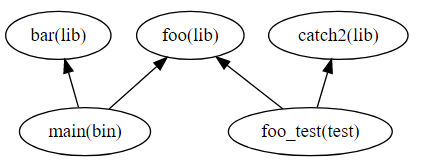Show how to compute the code coverage in Bazel that is relevant for a specific target using a very simple example.
For the moment this example is applicable to Linux and using gcc.
In this example we have declared 5 targets. A binary that depends on two libraries and a test that also depend on two libraries but only one common library with the binary.
Our application that we want to build and analize the code coverage is the maintarget.
You can see it better in the picture below:
What we want to show in this example is how to compute the code coverage considering two steps, the initial/baseline coverage, and the coverage computed when running the tests. To simplify the example we will only have one test. Having more than one test would require additionally to aggregate the coverage information for all tests.
The measures used for coverage that we will focus and we want to obtain are:
- Line coverage
- Function coverage
- Branch coverage
- Condition coverage
The first command that intuitively we would execute is:
bazel coverage //:foo_testThis will run the foo_test collecting the coverage information and generating a .dat file. Then we can run genhtml passing the output file to generate an html report.
genhtml --output-directory coverage-report bazel-testlogs/foo_test/coverage.datConsidering that we are interested in the coverage of the main target and all of its dependencies, we would expect to find in the report the files of the foo, bar, and main target. We are not interested on the coverage of the foo_test as well as the catch2.
Let's see what we have:
In the generated html only the foo target appears, showing a line coverage of 80% but in reality is much lower because main and bar have not been considered. Regarding the coverage measures we only see line coverage and function coverage.
Let's summarize per target:
-
fooshould appear -
barshould appear -
mainshould appear -
foo_testshould not appear -
catch2should not appear
And per feature:
- Line coverage
- Function coverage
- Branch coverage
- Condition coverage
As we can see in the related Bazel github issues, Bazel is not supporting baseline coverage and this is why the report is wrong.
We can workaround the problem mentioned above doing the follow:
First we clean the bazel-out to make sure that we do not have any previous coverage file:
bazel clean --expungeThen we compile the target for what we want to know the coverage adding the additional --collect_code_coverage parameter:
bazel build //:main --collect_code_coverageAfter that, we run lcov from the root of the workspace to generate the coverage_baseline.dat:
lcov -c --follow -i -d bazel-out/ -o coverage_baseline.datThis command will search for the coverage files generated during the compilation and will aggregate the information into the coverage_baseline.dat file.
Once we have the baseline coverage, we run the tests with bazel coverage to get the coverage information when running the tests:
bazel coverage //:foo_testThis will generate the coverage.dat file that we saw above.
If you open in a file editor coverage_baseline.dat and coverage.dat you will see that the first one has /proc/self/cwd/ pre appended in all the file paths. In order to be able to combine it with the file generated from bazel coverage need to unify the paths. We can do it with:
sed -i 's,/proc/self/cwd/,,g' coverage_baseline.datNow we can combine both files with the following command to get the final coverage file.
lcov -a coverage_baseline.dat -a bazel-testlogs/foo_test/coverage.dat -o final_coverage.datLike we did before we can now run genhtml to generate an html report.
genhtml --output-directory coverage-report final_coverage.datLet's see now what we get in the report:
In the generated html foo, bar and main targets appear, showing a line coverage of 36.4%, much lower than before but now much more correct because bar and main targets are considered. Regarding the coverage measures we still only see line coverage and function coverage.
Let's summarize per target:
-
fooshould appear -
barshould appear -
mainshould appear -
foo_testshould not appear -
catch2should not appear
And per feature:
- Line coverage
- Function coverage
- Branch coverage
- Condition coverage


